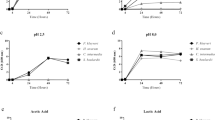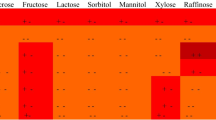Abstract
Food-grade yeasts make significant contributions to flavor development in fermented foods. Some yeast species also inhibit undesirable bacteria, yeasts and molds, apparently by producing antimicrobial compounds called mycocins. The aim of this study was to evaluate the ability of wild yeasts, isolated from raw milk and cheese in the Quebec province area, to produce antilisterial compounds. Based on an agar-membrane screening test, 22 of 95 isolates, namely one Candida catenulata, one Candida parapsilosis, five Candida tropicalis, four Debaryomyces hansenii, one Geotrichum candidum, nine Pichia fermentans and one Pichia anomala, exhibited a significant inhibitory effect against Listeria ivanovii HPB28. Four in particular, namely C. tropicalis LMA-693, D. hansenii LMA-916, P. fermentans LMA-256 and P. anomala LMA-827, produced substances extractable from culture supernatant and capable of decreasing 18-h growth of L. ivanovii by, respectively, 97, 92, 84 and 78 %. Heating the extracted material (100 °C for 10 min) decreased these values to 72, 62, 58 and 31 %, respectively, while treatment with trypsin or pronase E decreased them to as little as 27 %. The extracts reduced the numbers of viable Listeria monocytogenes by as much as four log cycles within an hour. Transmission electron microscopy revealed a high proportion of lysis among the cells, apparently due to pore formation. This study clearly shows the potential of these four yeast isolates for use as bio-preservatives in a variety of dairy products.







Similar content being viewed by others
References
Caplice E, Fitzgerald GF (1999) Food fermentations: role of microorganisms in food production and preservation. Int J Food Microbiol 50:131–149. doi:10.1016/S0168-1605(99)00082-3
Cavalero DA, Cooper DG (2003) The effect of medium composition on the structure and physical state of sophorolipids produced by Candida bombicola ATCC 22214. J of Biotechnol 103:31–41. doi:10.1016/S0168-1656(03)00067-1
Chen LS, Ma YING, Maubois JL, Chen LJ, Liu QH, Guo JP (2010) Identification of yeasts from raw milk and selection for some specific antioxidant properties. Int J of Dairy Technol 63:47–54. doi:10.1111/j.1471-0307.2009.00548.x
Dieuleveux V, Van der Pyl D, Chataud J, Gueguen M (1998) Purification and characterization of antilisterial compounds produced by Geotrichum candidum. Appl Environ Microbiol 64:800–803
Fatichenti F, Bergere JL, Deiana P, Farris GA (1983) Antagonistic activity of Debaryomyces-Hansenii towards Clostridium-Tyrobutyricum and Clostridium-Butyricum. J Dairy Res 50:449–457
Fredlund E, Druvefors U, Boysen ME, Lingsten KJ, Schnürer J (2002) Physiological characteristics of the biocontrol yeast Pichia anomala J121. FEMS Yeast Res 2:395–402. doi:10.1111/j.1567-1364.2002.tb00109.x
Gálvez A, Abriouel H, López RL, Omar NB (2007) Bacteriocin-based strategies for food biopreservation. Int J Food Microbiol 120:51–70. doi:10.1016/j.ijfoodmicro.2007.06.001
Gálvez A, Abriouel H, Omar NB, Lucas R (2011) Food applications and regulation. In: Rebuffat S, Drider D (eds) Prokaryotic antimicrobial peptides. Springer, New York, pp 353–390
Gibson GR, Wang X (1994) Regulatory effects of Bifidobacteria on the growth of other colonic bacteria. J Appl Microbiol 77:412–420. doi:10.1111/j.1365-2672.1994.tb03443.x
Goerges S, Aigner U, Silakowski B, Scherer S (2006) Inhibition of Listeria monocytogenes by food-borne yeasts. Appl Environ Microbiol 72:313–318. doi:10.1128/AEM.72.1.313-318.2006
Goerges S, Koslowsky M, Velagic S, Borst N, Bockelmann W, Heller KJ, Scherer S (2011) Anti-listerial potential of food-borne yeasts in red smear cheese. Int Dairy J 21:83–89. doi:10.1016/j.idairyj.2010.08.002
Golubev WI (2006) Antagonistic interactions among yeasts. In: Peter G, Rosa C (eds) Biodiversity and ecophysiology of yeasts. Springer, Berlin, pp 197–219
Lavoie K, Touchette M, St-Gelais D, Labrie S (2012) Characterization of the fungal microflora in raw milk and specialty cheeses of the province of Quebec. Dairy Sci Technol 1–14. doi:10.1007/s13594-011-0051-4
Liao CC, Yousef AE, Chism GW, Richter ER (1994) Inhibition of Staphylococcus aureus in buffer, culture media and foods by Lacidin-A, a bacteriocin produced by Lactobacillus-Acidophilus Osu133. J Food Saf 14:87–101
Liu SQ, Tsao M (2009) Biocontrol of dairy moulds by antagonistic dairy yeast Debaryomyces hansenii in yoghurt and cheese at elevated temperatures. Food Control 20:852–855. doi:10.1016/j.foodcont.2008.10.006
Magliani W, Conti S, Giovati L, Polonelli L (2010) Yeast killer toxins technology transfer. In: Rai M, Varma A (eds) Mycotoxins in food, feed and bioweapons. Springer, Berlin, pp 275–290
Meinhardt F, Klassen R (2009) In: Anke T, Weber D (eds) Yeast killer toxins: fundamentals and applications physiology and genetics, 15th edn. Springer, Berlin, pp 107–130
Passoth V, Olstorpe M, Schnurer J (2011) Past, present and future research directions with Pichia anomala. Antonie Van Leeuwenhoek Int J Gen Mol Microbiol 99:121–125. doi:10.1007/s10482-010-9508-3
Polonelli L, Magliani W, Ciociola T, Giovati L, Conti S (2011) From Pichia anomala killer toxin through killer antibodies to killer peptides for a comprehensive anti-infective strategy. Antonie Van Leeuwenhoek Int J Gen Mol Microbiol 99:35–41. doi:10.1007/s10482-010-9496-3
Polonelli L, Morace G (1986) Reevaluation of the yeast killer phenomenon. J Clin Microbiol 24:866–869
Stiles ME (1996) Biopreservation by lactic acid bacteria. Antonie Van Leeuwenhoek 70:331–345
Suzuki C, Ando Y, Machida S (2001) Interaction of SMKT, a killer toxin produced by Pichia farinosa, with the yeast cell membranes. Yeast 18:1471–1478
Turcotte C, Lacroix C, Kheadr E, Grignon L, Fliss I (2004) A rapid turbidometric microplate bioassay for accurate quantification of lactic acid bacteria bacteriocins. Int J Food Microbiol 90:283–293. doi:10.1016/S0168-1605(03)00315-5
van den Tempel T, Jakobsen M (2000) The technological characteristics of Debaryomyces hansenii and Yarrowia lipolytica and their potential as starter cultures for production of Danablu. Int Dairy J 10:263–270. doi:10.1016/S0958-6946(00)00053-4
Yang RG, Ray B (1994) Prevalence and biological-control of bacteriocin-producing psychrotrophic leuconostocs associated with spoilage of vacuum-packaged processed meats. J Food Prot 57:209–217
Young TW, Yagiu M (1978) A comparison of the killer character in different yeasts and its classification. Antonie Van Leeuwenhoek 44:59–77
Acknowledgments
This research was financially supported by a grant from the Fonds de recherche sur la nature et les technologies Québec (FQRNT), the Ministère de l’Agriculture, des Pêcheries et de l’Alimentation du Québec (MAPAQ), Novalait, and Agriculture and Agri-Food Canada (AAC). The authors wish to thank Alain Goulet (Laval University, Quebec, Canada) for his excellent technical assistance in electron microscopy. The authors are also grateful to Dr. Fadi Hatoum (Irish Separation Science Cluster (ISSC), Dublin City University, Ireland) and Dr. Tanya d’Anger (Sheridan College, Ontario, Canada) for their critical reading of the manuscript.
Author information
Authors and Affiliations
Corresponding author
Rights and permissions
About this article
Cite this article
Hatoum, R., Labrie, S. & Fliss, I. Identification and Partial Characterization of Antilisterial Compounds Produced by Dairy Yeasts. Probiotics & Antimicro. Prot. 5, 8–17 (2013). https://doi.org/10.1007/s12602-012-9109-8
Published:
Issue Date:
DOI: https://doi.org/10.1007/s12602-012-9109-8




